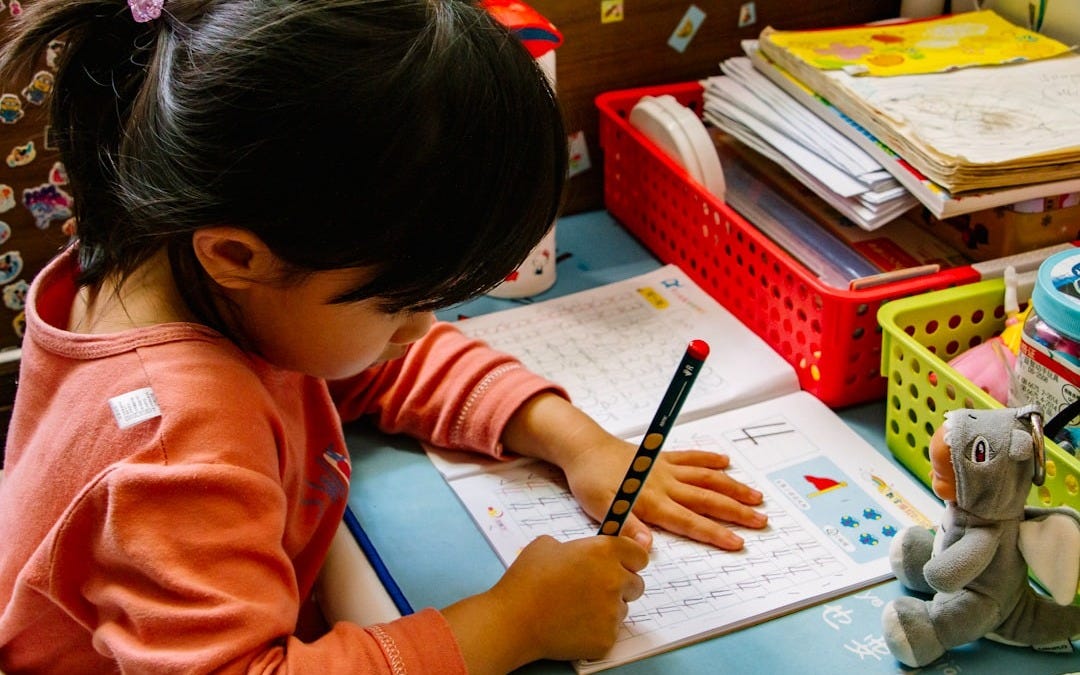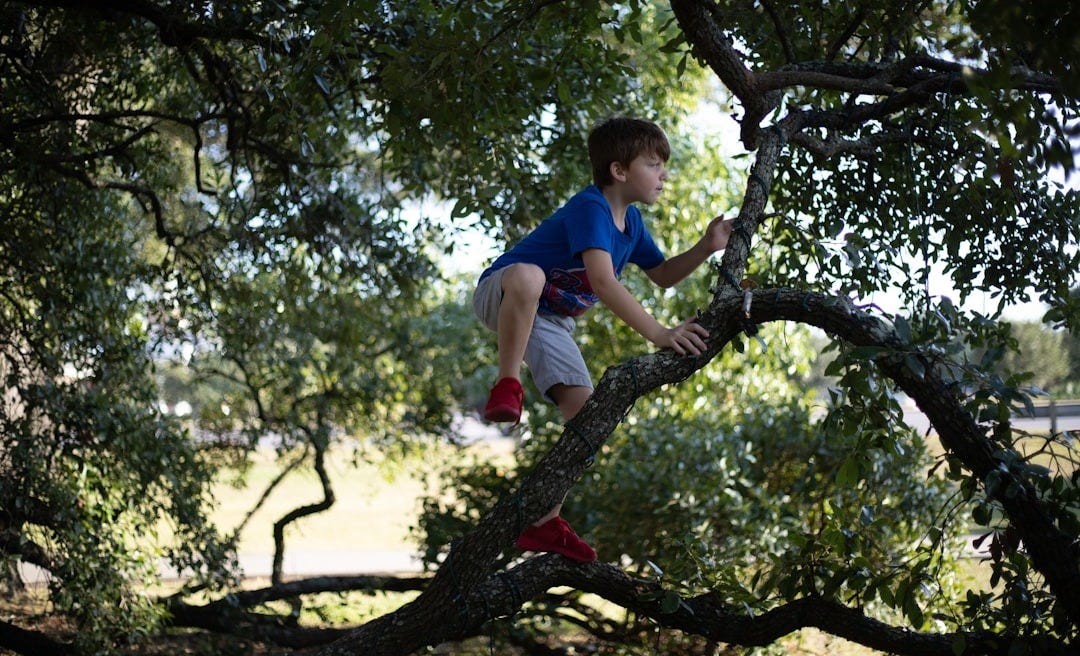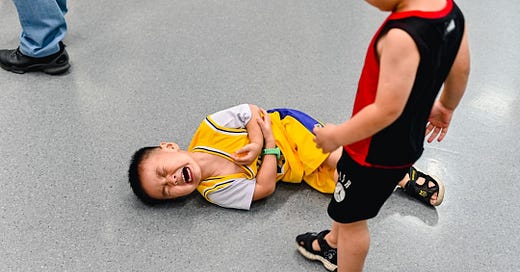Behavior Problems or Play Deprivation Problems?
What if most of those so-called "behavior problems" are just kids trying to move, communicate, and cope in a world they aren't adapted for?
A student sharpened a pencil down to the metal stub the other day. Not because she needed it. Not because she wanted to draw or had anything to write. She just…didn’t know what else to do with herself.
She tapped. She hummed. She squirmed. She asked for water. Asked to go to the bathroom. Then asked again. And finally, when all else failed, she obliterated a perfectly good Ticonderoga into a pile of golden curls. That’s when the other kids got annoyed. That’s when I noticed.
And that’s when I momentarily thought to myself:
“We’ve really got to work on her behavior.”
But upon further reflection, behavior wasn’t the problem.
At least, not in the way we think it is.
Rewriting the Script
That girl isn’t defiant. She’s dysregulated.
That boy who squirms in his seat? He doesn’t have a sitting problem. He has a movement problem.
The one who walks around the room, stares out the window, and won’t follow directions? He’s not necessarily disrespectful. He’s most-likely unmoored, floating around in a system that forgot what his body, brain, and heart actually need.
If we’re honest, we’ve all had these kids in our rooms. You may have one right now. Maybe four. Maybe half the class. And they’re not thriving. But neither are you. Because you were trained to teach lessons, not subdue cortisol-soaked nervous systems that haven't been outside all day and are fighting an internal battle to comply against their very biology, or risk getting in trouble.
We label it “disruptive behavior.”
We call for interventions.
We print sticker charts.
We schedule meetings.
But we almost never ask the question that matters most:
How many hours of free play is this child getting each day? Is it the 1-2 hours minimum the CDC states is necessary for school age children?

What Happens When Childhood Vanishes?
It’s not just a feeling. It’s not just nostalgia. Childhood has actually changed, and not for the better. Psychologist Peter Gray, one of the world’s leading researchers on play, puts it this way:
“Over the past five decades or more we have seen a continuous and overall huge decline in children’s freedom to play. With every decade children have become less free to play, roam, and explore. And with every decade, children have become more anxious, more depressed, and less emotionally resilient.”
Think about that: as play declines, behavior challenges and emotional fragility rise.
It’s not a coincidence.
The truth is, our children are not broken. They’re just biologically out of sync with our classrooms. They were wired for movement, creativity, face-to-face social interaction, and engaging with the wide world around them. Instead, we too often make them stay in one spot for long periods of time, give them wiggle seats, bouncy bands, screens, and GoNoodle to help them fight their urge to…be kids.
It’s like trying to raise a dolphin in a birdcage.
What Neuroscience Knows That Schools Ignore
The prefrontal cortex, the seat of emotional regulation, focus, impulse control, and empathy doesn’t mature through lectures or lessons. It develops through experiences. And one of the most powerful drivers of that development?
You guessed it: unstructured, child-led play.
In free play, children experience natural conflict and cooperation. They experiment with risk, learn to listen, negotiate boundaries, adapt to change, recover from failure, and read social cues in real time.
These aren’t soft skills. These are survival skills, and play is how they’re built. It’s why kids have such a strong innate drive to play.
Dr. Stuart Brown, founder of the National Institute for Play, has said:
“Play is not frivolous. It is brain building. It has a biological place just like sleep.”
When we cut recess, over-structure the day, or make play something kids earn by complying, we’re not taking away their fun, we’re actually starving their executive function. We are depriving their brains of something they need biologically to be mentally healthy and well. Then we wonder why they can’t sit still, follow directions, or get along with others.
We’re not facing a behavior crisis.
We’re facing a play famine.
The Data That Made Me Pay Attention
Let me tell you what changed my thinking.
Seven years ago, the behavior referrals at my school were high. The usual suspects: aggression, disrespect, shouting, refusal to follow directions. Students were melting down over trivial things, staff was exhausted, and I kept hearing the same phrase over and over:
“Kids today just aren’t what they used to be. They used to be able to listen, follow directions, and get along with each other.”
But no one could explain why they changed.
I had no clue either until I read researchers like Dr. Peter Gray, Dr. Stuart Brown, and Lenore Skenazy. I then started asking a different question, not “What do we do when a kid misbehaves?” but “What does a kid need so behaviors don’t even become an issue in the first place?”
The answer?
Unstructured play.
Real free play.
Messy, loud, old-school, child-led, play.
So we created before-school and after-school Play Clubs at my school.
No rules beyond safety. No adult-directed games or hovering. Just 90 minutes of outdoor freedom after school and 30 minutes before school each day.
We expected some improvement. What we saw was a transformation.
Behavior Down, Learning Up
Here’s what happened over the next year:
“Physical Acts” of aggression (kicking/hitting/pushing): dropped from 65 to 32
Verbal threats: went from 9 incidents to zero
Office referrals for “defiance” or “non-compliance”: cut in half
Academic scores: ticked upward, in all core subject areas
School bus referrals: dropped dramatically
Student joy and connection: impossible to quantify but impossible to miss
Kids who had been labeled “problem students” began smiling again.
One student who had been written off as angry and aggressive became a leader.
Another who was completely withdrawn began initiating group games.
One who was new to our country and had never spoken, even with a school-provided pocket translator, began speaking.
This wasn’t magic. It was biology. We met their brain’s and bodies’ needs, and their behavior followed…because it finally could.
It’s Not About More SEL Lessons
You can’t worksheet your way out of what only experience can build. When a child is crying under a table, no behavior chart will reach them. When a child explodes at a peer, no “bad choice vs. good choice” behavior poster will save the moment. You can’t lecture a child into having the right qualities and characteristics.
They don’t need more regulation strategies, they need more regulation opportunities.
That happens on monkey bars. In games of tag. In sandlot conflicts. In the spaces where no adult is coaching every move and every emotion.
Behavior isn’t taught. It’s cultivated. Through play. As it always has been since the dawn of humanity.
If you want a student to learn their multiplication facts you give them time to practice them again and again. So why would social emotional skills be any different? We must give kids time, space, and freedom to do what they need to do to. To learn life’s most important skills and gain life’s most important characteristics. Children must be with their peers in a thousand different circumstances, have a thousand different interactions (positive and negative), and be allowed to try, fail, pick themselves up, and try again in the low-stakes setting free play provides.
What If We Flipped the Question?
Instead of asking, “How can I get this student to comply?” what if we asked:
How much free play has this child had today?
How many decisions have they made on their own this week?
Have they had the chance to be a kid, or have they just been performing compliance for adults all day?

Photo by Jeremiah Lawrence on Unsplash
The Call Is Coming from Inside the Classroom
So much of the frustration we feel as educators right now isn’t because we’re failing. It’s because we’ve been given a version of school that doesn’t align with what kids actually are.
We expect fish to climb trees and then make them fill out a reflection sheet when they flop.
We need to rehumanize the classroom.
That starts with this truth:
Kids aren’t problems to solve. They are humans we get to help cultivate.
Humans need other humans. We thrive on connection, friendship, and a sense of community. They are essential ingredients for happiness and mental well-being. For children, unstructured play offers all of these in a natural and powerful way.
Sacred Space
This isn’t about being anti-structure. This is about being pro-child.
It’s not about throwing out routines or ignoring boundaries. It’s about knowing the why behind the behavior, and realizing that what looks like “bad behavior” is often just a desperate search for the connection, control, communication, and movement their growing bodies and brains require.
If you’re a parent, ask yourself: when was the last time your child got truly bored, and then made up something amazing?
If you’re a teacher, ask yourself: how many of your “behavior kids” are the same ones who come alive at recess?
If you’re an administrator, ask yourself: what would change if we doubled recess?
It’s not pie-in-the-sky. It’s dirt-under-the-fingernails, sweat-on-the-brow, smile-on-the-face real.
The fix is not another program.
It’s not another acronym.
It’s not another app.
It’s a tree. A field. Some grass. Some time.
And the sacred space to let kids just be kids.
Let Them Play
The kids aren’t misbehaving. They’re signaling. They’re telling us, with their bodies, their voices, their chaos, what they need.
Let’s stop punishing them for it. Let’s start listening. Let’s give them back what we’ve mistakenly taken away.
Let them play.
And watch what happens next.





Hi Kevin! Grateful for connecting with you and see your post. Just subscribed to you. Same as you, I do believe PLAY is very important in child development. It provides natural connection between kids and care givers / educators.
As a dad, I recently read and did some research on playful parenting. Once I used the mindsets of PLAY, parenting feels different. I also feel better connection with my kid.
In the end, we don’t really have much time to play with kids. A deprivation problem. Similar to your point, you may find one of my posts interesting. I estimated the time parents can actually have with their kids: just 1.3 years or 15 months of play time in their whole life.
https://playfulbrains.substack.com/p/you-only-have-13-years-of-playtime
🙌 This reminds me of the quote: “children succeed as much we let them.” We have to provide them with an environment that allows them to thrive, not suppress their nature… not deprive them _of_ nature.